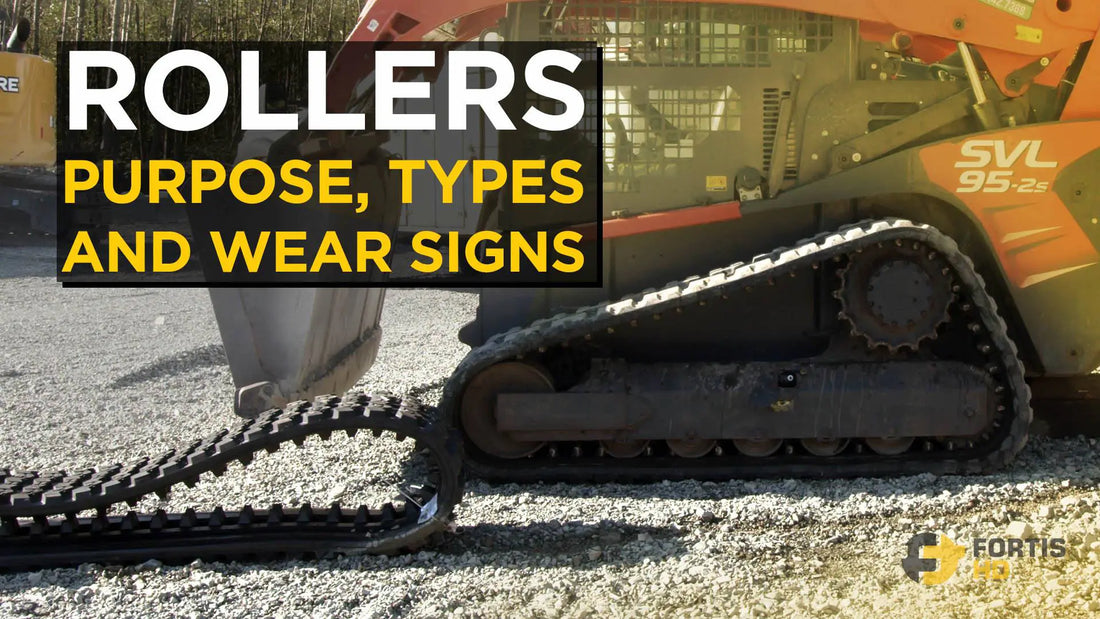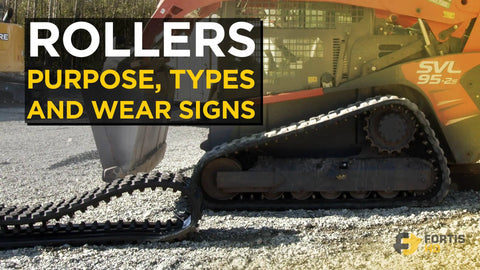
A Thorough Explanation of Heavy Equipment Rollers: Purpose, Types, and Wear Signs
Written by Luis Montes
Updated On August 26, 2024

Featured Tools
+

Written by Luis Montes
Updated On August 26, 2024

+
Tracked heavy equipment relies on rollers to:
We’ll cover how rubber track rollers achieve the above, their different types, and the most common signs of wear.

The undercarriage frame is the base support for the machine and the loads it handles.
The frame has rollers bolted to it, which receive the loads and spread them along the rubber track.
In addition, bottom rollers rely on bearings to easily displace the carrying loads along the track.

Tracks are heavy and flexible. Due to their weight, it doesn’t take much length to make them sag.
Without top rollers, the front idler of a tracked machine would have to overstretch the tracks to prevent sagging. But even so, the portion of the track between the sprocket and the front idler would be too slender, causing the track to twist and derail when the sprocket pushes it.
Top rollers provide mid-support points between the sprocket and front idler to reduce slenderness, keeping the track from sagging and twisting. Carrier rollers with flanges also prevent tracks from derailing.

Small-sized equipment doesn’t need a top roller because track slenderness and sagginess depend mostly on the undercarriage length. On the other hand, compact track loaders don’t need a carrier roller because the sprocket position functions as an offset support to the track.
However, larger equipment with steel tracks, such as dozers, need carrier rollers, even with a high-drive undercarriage.
The following table confirms the above:
| Equipment | Tumbler Distance* | Rollers |
|---|---|---|
| Small Size Frame | ||
| Kubota U17 | 4 ft. (1,230 mm) | 3 bottom rollers, no top roller |
| Bobcat MT100 | 2 ft. 10 in. (864 mm) | 4 bottom rollers, no top roller |
| Mid Size Frame | ||
| John Deere 35G | 5 ft. 5 in. (1,660 mm) | 4 bottom rollers & 1 top roller |
| John Deere SVL75-2 | 4 ft. 8.5 in. (1,436 mm) | 5 bottom rollers, no top roller |
| Large Size Frame | ||
| John Deere 60G | 6 ft. 6 in. (1,990 mm) | 4 bottom rollers & 1 top roller |
| Kubota SVL97-2 | 5 ft. 5.6 in. (1,667 mm) | 5 bottom rollers, no top roller |
| Cat D6N LGP (high-drive and steel frame) |
8 ft. 6.6 in. (2,605 mm) | 7 bottom rollers & 1 top roller |
* The tumbler distance is the measurement between the centers of the front idler and the sprocket on the tracks.

Rollers can have one of the following parts arrangement (besides the one shown in the image above):

Rollers with rolling bearings:
The bearings support the machine’s weight and allow it to roll with reduced friction along the rubber track. Each type has pros and cons.

Although rolling bearings greatly reduce friction, they are also susceptible to damage from impact loads.
On the other hand, sleeve bearings have more payload and better resist impact loads but are less efficient at reducing friction. The shaft of sleeve bearings has drillings to feed oil to the end caps to minimize friction.

The most noticeable variation of rubber track rollers is their flanges.
There are inner, dual-outer, and triple-flange bottom rollers.
Depending on their design, rollers can use their flanges to keep the machine within the track’s drive lugs or transmit the loads to the rubber track while preventing derailment.
Rollers with an inner flange (such as those on the John Deere 35G) ride on the rubber track guide lugs. The flange keeps the roller within the guide lug path to prevent derailment.


Outer flange rollers can ride on the rubber track guide lugs, while others do so on the track’s rubber compound, such as the ones on the Kubota KX040.
As our Kubota KX040, John Deere 35G and John Deere 60G mini excavator reviews mention, dual-flange rollers offer better stability than single inner-flange ones, especially when slewing and digging over the side.

Fortis HD has OEM-endorsed aftermarket track rollers for the most popular brands and models of mini excavators and skid steers.
Get your undercarriage replacement rollers and experience unparalleled quality, unwavering reliability, and long-lasting durability.
The number and size of teeth and the overall design of the sprocket can vary depending on the equipment’s type, size, and brand.
Although one can get to that conclusion intuitively, we’ll demonstrate it with a simple calculation:
When a compact excavator digs over the side, the boom generates a moment over the rollers, decomposing into two forces acting on the flanges. As the support points get further apart, the forces on the flanges decrease, improving stability.

m (moment) = (f1 x a/2) + (f1 x a/2) → 2 x (f1 x a/2) → f1 x a → f1 = m / a.
As the value of “a” increases, “f” decreases. The magnitude of f2 is smaller than f1, proving how dual flange rollers are more stable than inner flange ones.

Some compact excavators, like the Takeuchi TB260, feature triple-flanged rollers, further decreasing detracking by allowing the track to maintain at least two contact points.
The bottom rollers on compact track loaders also have triple-flanged rollers. Their outer flanges roll on the track’s rubber compound, transmitting the loads.

The drive lugs on CTL rubber tracks are taller, providing more contact surface with the flanges of the bottom rollers, which greatly helps minimize the chances of track derailment.

Bearings are the components experiencing the most fatigue and will eventually fail on rollers.
Excessive oil sweating indicates that the seals on your rollers are starting to fail. A squeaky undercarriage is, however, a clear sign of bottom or top roller failure.
While track rollers lose lubrication, friction increases to the point where the bearings break and fall out of the rollers. The shaft will hang loosely in the roller housing, producing a squealing noise.
A worn-out roller will easily move if you wiggle it with your hands, especially when its bearings are gone.
Flanges will also wear due to constant rubbing against the rubber track drive lugs. Though sharp flanges won’t affect operations like damaged bearings, they will accelerate the wear of rubber tracks.

Replace your worn-out rollers with the best aftermarket replacement parts from Fortis HD.
Check our undercarriage section for OEM-approved aftermarket CTL loaders designed to exceed your expectations.
Carrier rollers keep the track from sagging, while bottom rollers carry and displace the machine’s weight and loads along the track—on the track’s guide lugs or rubber compound.
Compact-size machines can have single, dual, and triple flange rollers. Flanges keep the track within the track’s drive lugs and can also transmit loads to the rubber track.
Constant friction and impacts eventually wear bearings.
Squealing or grinding noises from your undercarriage are signs of rollers without bearings. Address it ASAP to avoid accelerating wear on the idlers and the sprocket. Although replacing rollers is straightforward, you can leave it to the expert mechanics from Tekamo HD, who will do it quickly.
Besides the rollers, the sprocket is another undercarriage component experiencing the most wear. Our sprocket article discusses the wear signs of sprockets and best practices to extend their lifespan. Check it out.